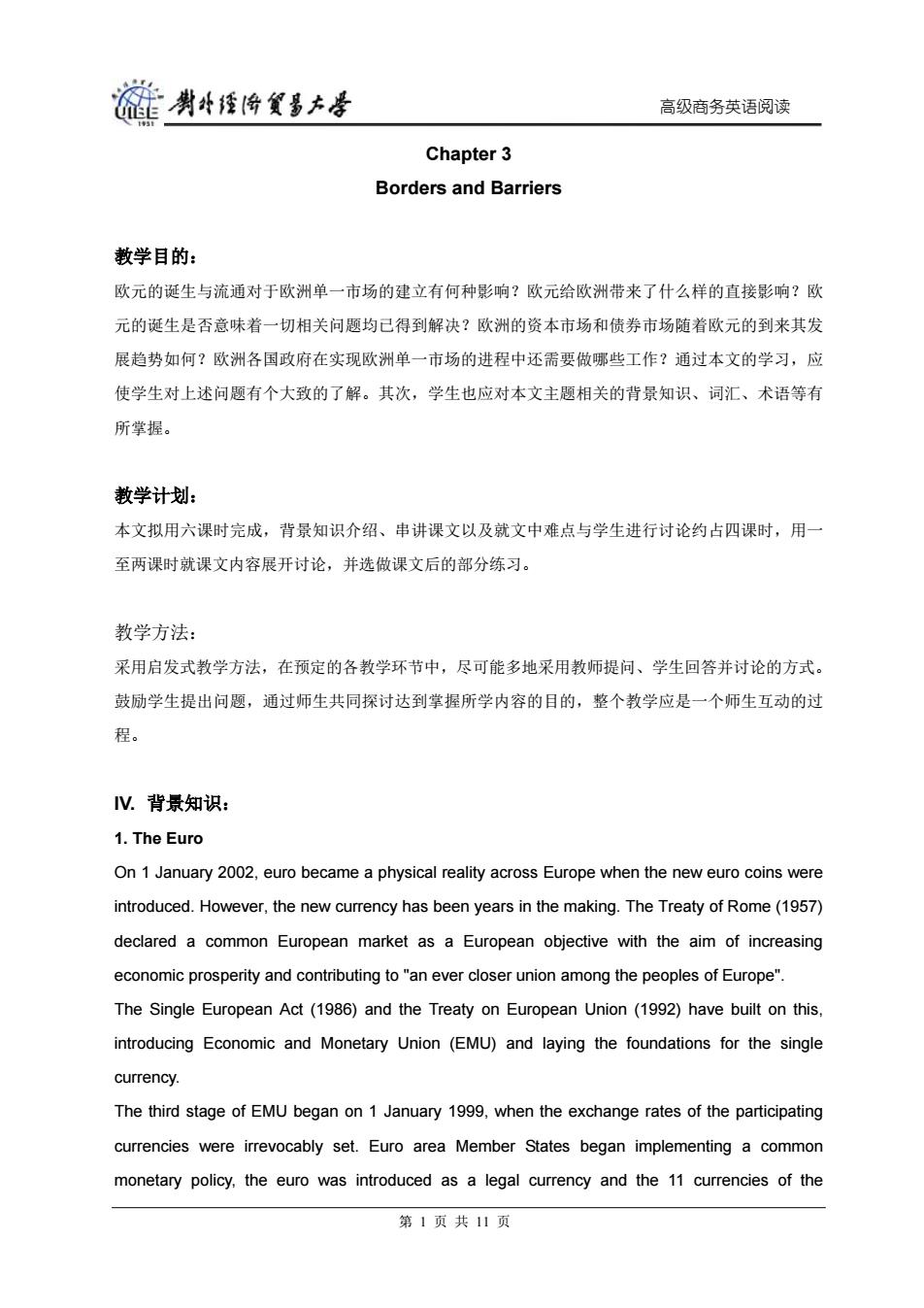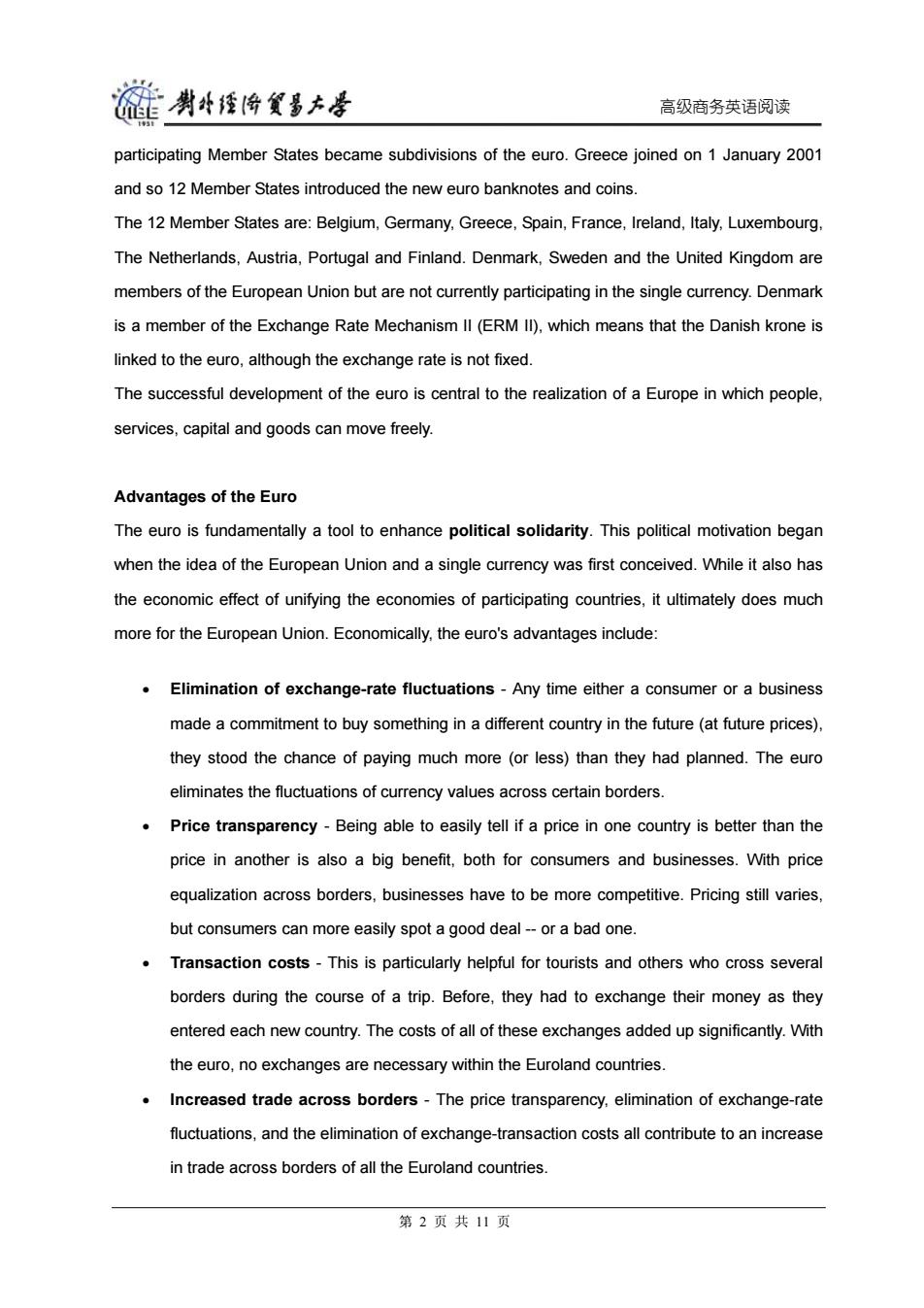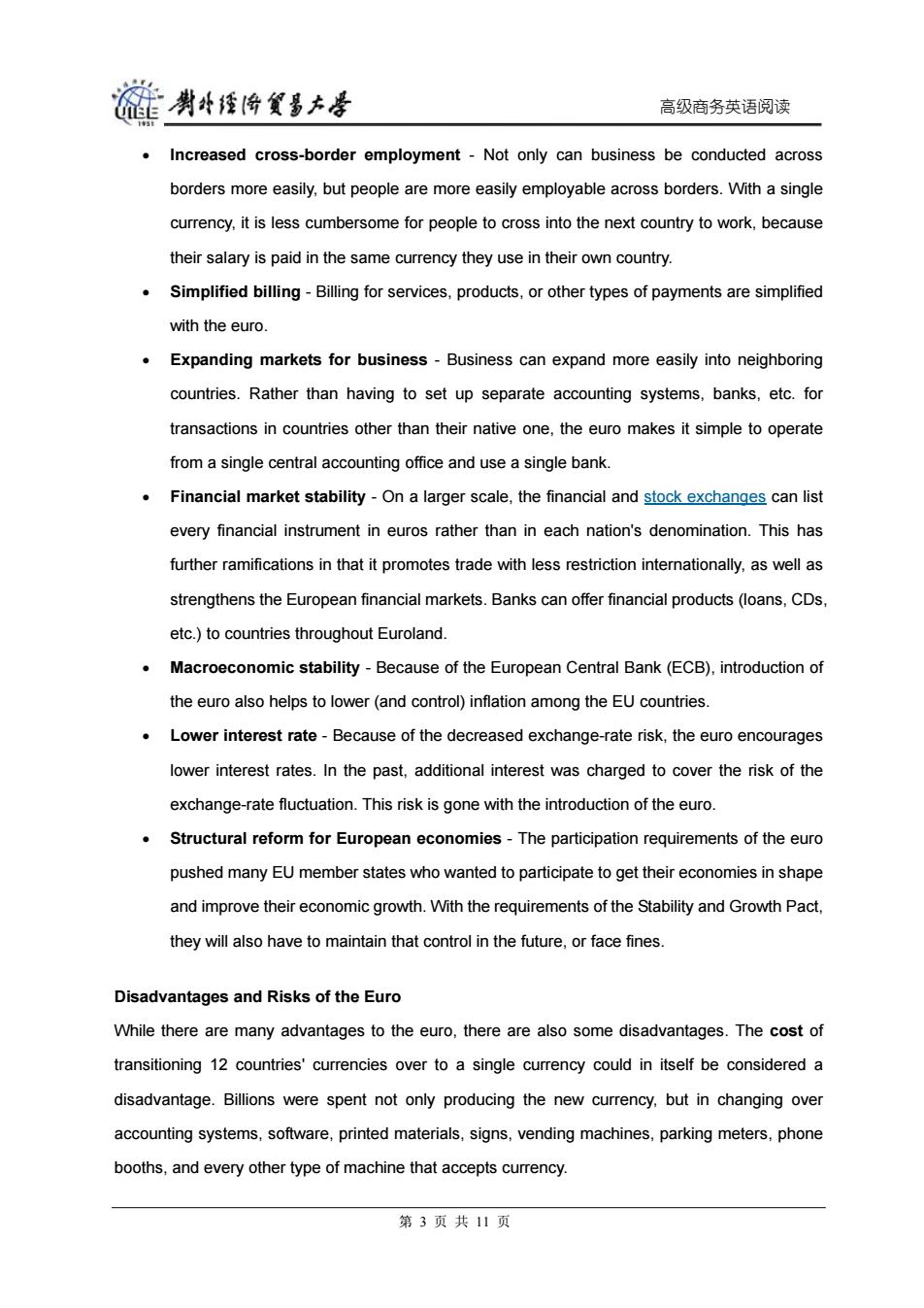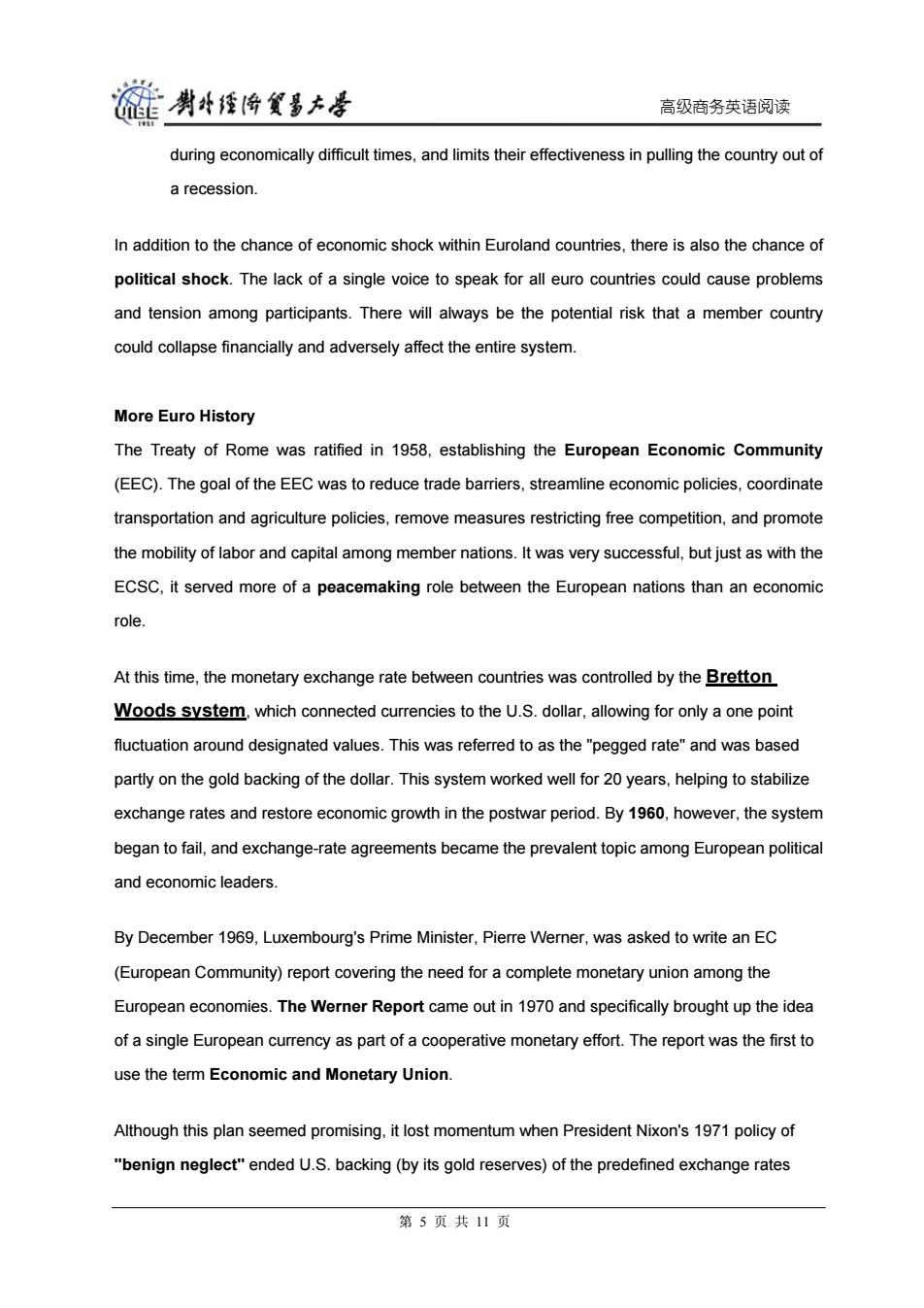
莲喇母矮降贸多大学 高级商务英语阅读 Chapter 3 Borders and Barriers 教学目的: 欧元的诞生与流通对于欧洲单一市场的建立有何种影响?欧元给欧洲带来了什么样的直接影响?欧 元的诞生是否意味着一切相关问题均已得到解决?欧洲的资本市场和债券市场随着欧元的到来其发 展趋势如何?欧洲各国政府在实现欧洲单一市场的进程中还需要做哪些工作?通过本文的学习,应 使学生对上述问题有个大致的了解。其次,学生也应对本文主题相关的背景知识、词汇、术语等有 所掌握。 教学计划: 本文拟用六课时完成,背景知识介绍、串讲课文以及就文中难点与学生进行讨论约占四课时,用一 至两课时就课文内容展开讨论,并选做课文后的部分练习。 教学方法: 采用启发式教学方法,在预定的各教学环节中,尽可能多地采用教师提问、学生回答并讨论的方式。 鼓励学生提出问题,通过师生共同探讨达到掌握所学内容的目的,整个教学应是一个师生互动的过 程。 IV.背景知识: 1.The Euro On 1 January 2002,euro became a physical reality across Europe when the new euro coins were introduced.However,the new currency has been years in the making.The Treaty of Rome(1957) declared a common European market as a European objective with the aim of increasing economic prosperity and contributing to"an ever closer union among the peoples of Europe". The Single European Act(1986)and the Treaty on European Union(1992)have built on this, introducing Economic and Monetary Union (EMU)and laying the foundations for the single currency. The third stage of EMU began on 1 January 1999,when the exchange rates of the participating currencies were irrevocably set.Euro area Member States began implementing a common monetary policy,the euro was introduced as a legal currency and the 11 currencies of the 第1页共11页
高级商务英语阅读 Chapter 3 Borders and Barriers 教学目的: 欧元的诞生与流通对于欧洲单一市场的建立有何种影响?欧元给欧洲带来了什么样的直接影响?欧 元的诞生是否意味着一切相关问题均已得到解决?欧洲的资本市场和债券市场随着欧元的到来其发 展趋势如何?欧洲各国政府在实现欧洲单一市场的进程中还需要做哪些工作?通过本文的学习,应 使学生对上述问题有个大致的了解。其次,学生也应对本文主题相关的背景知识、词汇、术语等有 所掌握。 教学计划: 本文拟用六课时完成,背景知识介绍、串讲课文以及就文中难点与学生进行讨论约占四课时,用一 至两课时就课文内容展开讨论,并选做课文后的部分练习。 教学方法: 采用启发式教学方法,在预定的各教学环节中,尽可能多地采用教师提问、学生回答并讨论的方式。 鼓励学生提出问题,通过师生共同探讨达到掌握所学内容的目的,整个教学应是一个师生互动的过 程。 IV. 背景知识: 1. The Euro On 1 January 2002, euro became a physical reality across Europe when the new euro coins were introduced. However, the new currency has been years in the making. The Treaty of Rome (1957) declared a common European market as a European objective with the aim of increasing economic prosperity and contributing to "an ever closer union among the peoples of Europe". The Single European Act (1986) and the Treaty on European Union (1992) have built on this, introducing Economic and Monetary Union (EMU) and laying the foundations for the single currency. The third stage of EMU began on 1 January 1999, when the exchange rates of the participating currencies were irrevocably set. Euro area Member States began implementing a common monetary policy, the euro was introduced as a legal currency and the 11 currencies of the 第 1 页 共 11 页

雒勇降贸多大是 高级商务英语阅读 participating Member States became subdivisions of the euro.Greece joined on 1 January 2001 and so 12 Member States introduced the new euro banknotes and coins. The 12 Member States are:Belgium,Germany,Greece,Spain,France,Ireland,Italy,Luxembourg, The Netherlands,Austria,Portugal and Finland.Denmark,Sweden and the United Kingdom are members of the European Union but are not currently participating in the single currency.Denmark is a member of the Exchange Rate Mechanism Il(ERM II),which means that the Danish krone is linked to the euro,although the exchange rate is not fixed. The successful development of the euro is central to the realization of a Europe in which people, services,capital and goods can move freely. Advantages of the Euro The euro is fundamentally a tool to enhance political solidarity.This political motivation began when the idea of the European Union and a single currency was first conceived.While it also has the economic effect of unifying the economies of participating countries,it ultimately does much more for the European Union.Economically,the euro's advantages include: Elimination of exchange-rate fluctuations-Any time either a consumer or a business made a commitment to buy something in a different country in the future(at future prices), they stood the chance of paying much more(or less)than they had planned.The euro eliminates the fluctuations of currency values across certain borders. Price transparency-Being able to easily tell if a price in one country is better than the price in another is also a big benefit,both for consumers and businesses.With price equalization across borders,businesses have to be more competitive.Pricing still varies, but consumers can more easily spot a good deal--or a bad one Transaction costs-This is particularly helpful for tourists and others who cross several borders during the course of a trip.Before,they had to exchange their money as they entered each new country.The costs of all of these exchanges added up significantly.With the euro,no exchanges are necessary within the Euroland countries. Increased trade across borders-The price transparency,elimination of exchange-rate fluctuations,and the elimination of exchange-transaction costs all contribute to an increase in trade across borders of all the Euroland countries. 第2页共11页
高级商务英语阅读 participating Member States became subdivisions of the euro. Greece joined on 1 January 2001 and so 12 Member States introduced the new euro banknotes and coins. The 12 Member States are: Belgium, Germany, Greece, Spain, France, Ireland, Italy, Luxembourg, The Netherlands, Austria, Portugal and Finland. Denmark, Sweden and the United Kingdom are members of the European Union but are not currently participating in the single currency. Denmark is a member of the Exchange Rate Mechanism II (ERM II), which means that the Danish krone is linked to the euro, although the exchange rate is not fixed. The successful development of the euro is central to the realization of a Europe in which people, services, capital and goods can move freely. Advantages of the Euro The euro is fundamentally a tool to enhance political solidarity. This political motivation began when the idea of the European Union and a single currency was first conceived. While it also has the economic effect of unifying the economies of participating countries, it ultimately does much more for the European Union. Economically, the euro's advantages include: • Elimination of exchange-rate fluctuations - Any time either a consumer or a business made a commitment to buy something in a different country in the future (at future prices), they stood the chance of paying much more (or less) than they had planned. The euro eliminates the fluctuations of currency values across certain borders. • Price transparency - Being able to easily tell if a price in one country is better than the price in another is also a big benefit, both for consumers and businesses. With price equalization across borders, businesses have to be more competitive. Pricing still varies, but consumers can more easily spot a good deal -- or a bad one. • Transaction costs - This is particularly helpful for tourists and others who cross several borders during the course of a trip. Before, they had to exchange their money as they entered each new country. The costs of all of these exchanges added up significantly. With the euro, no exchanges are necessary within the Euroland countries. • Increased trade across borders - The price transparency, elimination of exchange-rate fluctuations, and the elimination of exchange-transaction costs all contribute to an increase in trade across borders of all the Euroland countries. 第 2 页 共 11 页

莲剥4将发多大号 高级商务英语阅读 Increased cross-border employment -Not only can business be conducted across borders more easily,but people are more easily employable across borders.With a single currency,it is less cumbersome for people to cross into the next country to work,because their salary is paid in the same currency they use in their own country. Simplified billing-Billing for services,products,or other types of payments are simplified with the euro. Expanding markets for business-Business can expand more easily into neighboring countries.Rather than having to set up separate accounting systems,banks,etc.for transactions in countries other than their native one,the euro makes it simple to operate from a single central accounting office and use a single bank. Financial market stability-On a larger scale,the financial and stock exchanges can list every financial instrument in euros rather than in each nation's denomination.This has further ramifications in that it promotes trade with less restriction internationally,as well as strengthens the European financial markets.Banks can offer financial products (loans,CDs, etc.)to countries throughout Euroland. Macroeconomic stability-Because of the European Central Bank(ECB),introduction of the euro also helps to lower(and control)inflation among the EU countries. Lower interest rate-Because of the decreased exchange-rate risk,the euro encourages lower interest rates.In the past,additional interest was charged to cover the risk of the exchange-rate fluctuation.This risk is gone with the introduction of the euro. Structural reform for European economies-The participation requirements of the euro pushed many EU member states who wanted to participate to get their economies in shape and improve their economic growth.With the requirements of the Stability and Growth Pact, they will also have to maintain that control in the future,or face fines. Disadvantages and Risks of the Euro While there are many advantages to the euro,there are also some disadvantages.The cost of transitioning 12 countries'currencies over to a single currency could in itself be considered a disadvantage.Billions were spent not only producing the new currency,but in changing over accounting systems,software,printed materials,signs,vending machines,parking meters,phone booths,and every other type of machine that accepts currency. 第3页共11页
高级商务英语阅读 • Increased cross-border employment - Not only can business be conducted across borders more easily, but people are more easily employable across borders. With a single currency, it is less cumbersome for people to cross into the next country to work, because their salary is paid in the same currency they use in their own country. • Simplified billing - Billing for services, products, or other types of payments are simplified with the euro. • Expanding markets for business - Business can expand more easily into neighboring countries. Rather than having to set up separate accounting systems, banks, etc. for transactions in countries other than their native one, the euro makes it simple to operate from a single central accounting office and use a single bank. • Financial market stability - On a larger scale, the financial and stock exchanges can list every financial instrument in euros rather than in each nation's denomination. This has further ramifications in that it promotes trade with less restriction internationally, as well as strengthens the European financial markets. Banks can offer financial products (loans, CDs, etc.) to countries throughout Euroland. • Macroeconomic stability - Because of the European Central Bank (ECB), introduction of the euro also helps to lower (and control) inflation among the EU countries. • Lower interest rate - Because of the decreased exchange-rate risk, the euro encourages lower interest rates. In the past, additional interest was charged to cover the risk of the exchange-rate fluctuation. This risk is gone with the introduction of the euro. • Structural reform for European economies - The participation requirements of the euro pushed many EU member states who wanted to participate to get their economies in shape and improve their economic growth. With the requirements of the Stability and Growth Pact, they will also have to maintain that control in the future, or face fines. Disadvantages and Risks of the Euro While there are many advantages to the euro, there are also some disadvantages. The cost of transitioning 12 countries' currencies over to a single currency could in itself be considered a disadvantage. Billions were spent not only producing the new currency, but in changing over accounting systems, software, printed materials, signs, vending machines, parking meters, phone booths, and every other type of machine that accepts currency. 第 3 页 共 11 页

链剥将发多大是 高级商务英语阅读 In addition,there were hours of training necessary for employees,managers,and even consumers.Every government from national to local had impact costs of the transition.This enormous task required many hours of organization,planning,and implementation,which fell on the shoulders of government agencies. The chance of economic shock is another risk that comes along with the introduction of a single currency.On a macroeconomic level,fluctuations have in the past been controllable by each country. With their own national currencies,countries could adjust interest rates to encourage investments and large consumer purchases. The euro makes interest-rate adjustments by individual countries impossible,so this form of recovery is lost.Interest rates for all of Euroland are controlled by the European Central Bank. They could also devalue their currency in an economic downturn by adjusting their exchange rate.This devaluation would encourage foreign purchases of their goods,which would then help bring the economy back to where it needed to be. Since there is no longer an individual national currency,this method of economic recovery is also lost.There is no exchange-rate fluctuation for individual euro countries. A third way they could adjust to economic shocks was through adjustments in government spending,such as unemployment and social welfare programs.In times of economic difficulty,when lay-offs increase and more citizens need unemployment benefits and other welfare funding,the government's spending increases to make these payments.This puts money back into the economy and encourages spending,which helps bring the country out of its recession. Because of the Stability and Growth Pact,governments are restricted to keeping their budget deficits within the requirements of the pact.This limits their freedom in spending 第4页共11页
高级商务英语阅读 In addition, there were hours of training necessary for employees, managers, and even consumers. Every government from national to local had impact costs of the transition. This enormous task required many hours of organization, planning, and implementation, which fell on the shoulders of government agencies. The chance of economic shock is another risk that comes along with the introduction of a single currency. On a macroeconomic level, fluctuations have in the past been controllable by each country. • With their own national currencies, countries could adjust interest rates to encourage investments and large consumer purchases. The euro makes interest-rate adjustments by individual countries impossible, so this form of recovery is lost. Interest rates for all of Euroland are controlled by the European Central Bank. • They could also devalue their currency in an economic downturn by adjusting their exchange rate. This devaluation would encourage foreign purchases of their goods, which would then help bring the economy back to where it needed to be. Since there is no longer an individual national currency, this method of economic recovery is also lost. There is no exchange-rate fluctuation for individual euro countries. • A third way they could adjust to economic shocks was through adjustments in government spending, such as unemployment and social welfare programs. In times of economic difficulty, when lay-offs increase and more citizens need unemployment benefits and other welfare funding, the government's spending increases to make these payments. This puts money back into the economy and encourages spending, which helps bring the country out of its recession. Because of the Stability and Growth Pact, governments are restricted to keeping their budget deficits within the requirements of the pact. This limits their freedom in spending 第 4 页 共 11 页

莲类4睡降发多大号 高级商务英语阅读 during economically difficult times,and limits their effectiveness in pulling the country out of a recession. In addition to the chance of economic shock within Euroland countries,there is also the chance of political shock.The lack of a single voice to speak for all euro countries could cause problems and tension among participants.There will always be the potential risk that a member country could collapse financially and adversely affect the entire system. More Euro History The Treaty of Rome was ratified in 1958,establishing the European Economic Community (EEC).The goal of the EEC was to reduce trade barriers,streamline economic policies,coordinate transportation and agriculture policies,remove measures restricting free competition,and promote the mobility of labor and capital among member nations.It was very successful,but just as with the ECSC,it served more of a peacemaking role between the European nations than an economic role At this time,the monetary exchange rate between countries was controlled by the Bretton Woods system,which connected currencies to the U.S.dollar,allowing for only a one point fluctuation around designated values.This was referred to as the"pegged rate"and was based partly on the gold backing of the dollar.This system worked well for 20 years,helping to stabilize exchange rates and restore economic growth in the postwar period.By 1960,however,the system began to fail,and exchange-rate agreements became the prevalent topic among European political and economic leaders. By December 1969,Luxembourg's Prime Minister,Pierre Werner,was asked to write an EC (European Community)report covering the need for a complete monetary union among the European economies.The Werner Report came out in 1970 and specifically brought up the idea of a single European currency as part of a cooperative monetary effort.The report was the first to use the term Economic and Monetary Union. Although this plan seemed promising,it lost momentum when President Nixon's 1971 policy of "benign neglect"ended U.S.backing(by its gold reserves)of the predefined exchange rates 第5页共11页
高级商务英语阅读 during economically difficult times, and limits their effectiveness in pulling the country out of a recession. In addition to the chance of economic shock within Euroland countries, there is also the chance of political shock. The lack of a single voice to speak for all euro countries could cause problems and tension among participants. There will always be the potential risk that a member country could collapse financially and adversely affect the entire system. More Euro History The Treaty of Rome was ratified in 1958, establishing the European Economic Community (EEC). The goal of the EEC was to reduce trade barriers, streamline economic policies, coordinate transportation and agriculture policies, remove measures restricting free competition, and promote the mobility of labor and capital among member nations. It was very successful, but just as with the ECSC, it served more of a peacemaking role between the European nations than an economic role. At this time, the monetary exchange rate between countries was controlled by the Bretton Woods system, which connected currencies to the U.S. dollar, allowing for only a one point fluctuation around designated values. This was referred to as the "pegged rate" and was based partly on the gold backing of the dollar. This system worked well for 20 years, helping to stabilize exchange rates and restore economic growth in the postwar period. By 1960, however, the system began to fail, and exchange-rate agreements became the prevalent topic among European political and economic leaders. By December 1969, Luxembourg's Prime Minister, Pierre Werner, was asked to write an EC (European Community) report covering the need for a complete monetary union among the European economies. The Werner Report came out in 1970 and specifically brought up the idea of a single European currency as part of a cooperative monetary effort. The report was the first to use the term Economic and Monetary Union. Although this plan seemed promising, it lost momentum when President Nixon's 1971 policy of "benign neglect" ended U.S. backing (by its gold reserves) of the predefined exchange rates 第 5 页 共 11 页